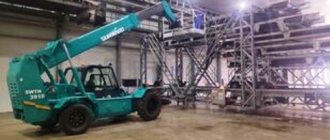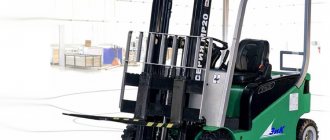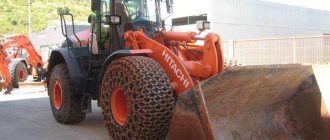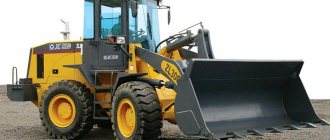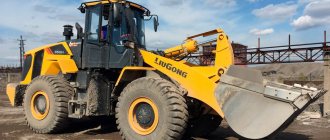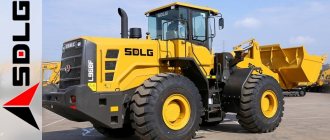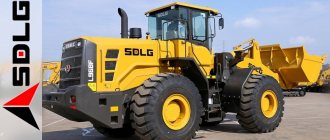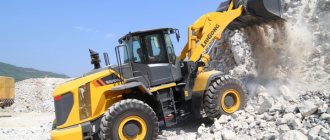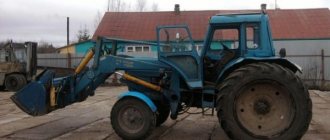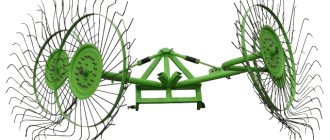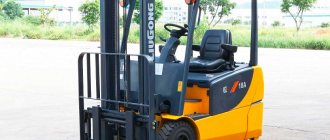A significant share in the construction of any infrastructure facility is occupied by earthworks. At a construction site, where work proceeds parallel to each other, it is necessary to remove and move soil, backfill, level, and remove debris. In the existing segment of the construction equipment market, a front loader based on the DT-75 occupies its niche.
Features of operation and manufacture of front loaders on DT-75 and MTZ
A significant share in the construction of any infrastructure facility is occupied by earthworks. At a construction site, where work proceeds parallel to each other, it is necessary to remove and move soil, backfill, level, and remove debris. In the existing segment of the construction equipment market, a front loader based on the DT-75 occupies its niche.
Design Features
DT-75 is a brand of bulldozer that has been produced by the Volgograd Tractor Plant for more than 50 years.
The DT-75 loader is designed as a tracked vehicle for work in difficult terrain and wooded and swampy areas. Wide tracks allow it to work on viscous and waterlogged soils, which are typical for Russian construction sites. The powerful motor ensures operation even on rough terrain or in a littered industrial area.
The factory-assembled bulldozer is equipped with a 75-horsepower SMD-14 engine. If necessary, it can be replaced with any modification of the SMD. Late DT models have Finnish engines, which with a power of 95 hp. equipped with a pre-heater. The Finnish motor brings the bulldozer to level 5 of the traction class (the standard machine has level 3).
The base and track of the DT-75 are 2365 and 3680 mm, respectively. The length of the machine reaches 3.86 m, width 1.75 m. The specific pressure on the ground reaches 0.04 MPa. An hour of operation consumes 15 liters of diesel fuel (the fuel tank is designed for 360 liters).
Depending on the type of work, attachments can be installed on the tractor. For example, you can replace the tracks with “swamp” ones with less pressure on the ground, equip them with transmission creepers, and install a bucket. The design features of the DT-75 allow it to accommodate loader equipment.
Device DT-75
The basic version of the caterpillar tractor weighing 5.5 tons and with dimensions of 4109.5 x 1740 x 2304 mm was driven by a 4-cylinder SMD-14 diesel engine (75 hp) with a service life of 3 thousand hours. Since the late 70s, it was replaced by an improved version of the SMD-14NG (80 hp). Also, various modifications of the tractor used engines A-41 (90 hp, model DT-75M), SMD-18N (95 hp, DT-75N), SMD-66 (170 hp, DT -75S), A-41I (94 hp, DT-75D and DT-75T), A-41SI (94 hp, DT-75DE), Belarusian D-245 (105 hp, DT -75ML, DT-75DM and DT-75T), RM-120 and RM-80 and (100 hp and 80 hp, DT-75RM).
Photo of the tracked model of the DT-75 tractor
The power plant is started using a starting engine. In winter, a pre-heater is used to warm up the diesel engine.
The DT-75 chassis consists of a welded frame (two rectangular-section spars connected by transverse round pipes), on which all components and mechanisms are mounted, rollers with rubber tires, guides and drive wheels, 4 suspension carriages and two track chains.
The clutch is a permanently closed type, 2-disc. The rear axle received two single-stage planetary rotating mechanisms. Band brakes, floating type.
To increase traction, the transmission may additionally include:
- torque multiplier (UKM, planetary gearbox with friction and roller clutches; gear ratio 1.25);
- creeper (mechanical gear 4-speed reducer);
- reverse gearbox (single-stage mechanical; forward gear ratio – 1.67; reverse gear – 1.35).
In order to expand the range, the DT-75 tractors use a power take-off shaft (PTO) driven from the UKM drive shaft or creeper.
The gearbox is 4-way (7 forward gears and one reverse), installed in the front compartment of the housing shared with the rear axle. The UCM or creeper mechanism is mounted on the front wall of the gearbox in a separate housing.
The basic model is equipped with a two-seat all-metal sealed cabin. The seat was adjusted according to the height and weight of the driver. Since 1978, the DT-75 has been supplied with a new sprung cab, which is shifted to the right of the central axis of the tractor to improve visibility.
To create comfortable working conditions, a ventilation device is used that supplies purified, cooled and humidified air into the cabin. In winter, the optimal air temperature is ensured by a hot-air heater.
Tractor diagram DT-75
1 - engine; 2 — cabin; 3 - fuel tank; 4 — levers of the mounted device; 5 — power take-off shaft; 6 — trailer bracket; 7 - drive wheel; 8 — central gear; 9 — caterpillar; 10 — gearbox; 11 — support wheel; 12 — clutch; 13 — guide wheel.
The tractor is equipped with a towbar, rear linkage and a separate hydraulic system. DT-75 can be mounted with almost any agricultural implements (mounted plows and harrows, bulldozers, potato diggers, seeders), including semi-mounted side ones (concrete pavers, loaders). And also with bulldozer, drilling and road construction equipment.
How to choose
When choosing equipment that is necessary for loading operations, it makes sense to compare the characteristics of construction machines of the same type: DT-75 and MTZ.
For DT-75
This machine can have several sets of attachments: for agricultural work, for general construction work, and drilling. A front-end loader on the DT-75 can be installed thanks to the installation of side-mounted semi-mounted equipment.
The updated modification of the DT, the engine for which is now produced in the city of Vladimir, has a new, more ergonomic cabin.
Loader specifications vary by model. PG 2 has a bucket with a capacity of 1.5 m³, the unloading height reaches 2.7 m with an angle of 50°. The width of the bucket edge (grip) is 2028 mm.
The PFP 1.2 front-end loader has a narrower specialization. It is designed for loading bulk materials and fertilizers. Its parameters:
- bucket capacity 0.9 m³;
- unloading height 2.5 m;
- working width 2035 mm.
In addition, combined and homemade loaders are used.
For MTZ
A loader based on the MTZ produced by the Minsk Tractor Plant is obtained by installing mounted units on the tractor. Its basis is a wide bucket with a grab for bulk materials. In the standard version (for example, the MTZ-1221 front loader) consists of:
- a controlled frame with a hydraulic system is the main part of the structure;
- chassis;
- nozzles
The MTZ-82, which has a kun as additional equipment, has also proven itself well. This is a swept unit controlled by four hydraulic drives. Two of them work in the horizontal plane, and two more regulate the movement of the bucket.
A standard mini tractor kit has the following characteristics:
- Load capacity from 500 to 800 kgf.
- The loading height is 2.5-3 m.
- The unloading angle of the bucket is 55°.
Various attachments allow you to use basic equipment for a wide range of work. It can be included in the delivery set or purchased separately for subsequent installation by the owner.
Front loaders ZTM-216 have the following technical characteristics:
| Name | Values | |
| Load capacity, t | 3,5 | |
| Bucket capacity, m | 1,7 — 2,0 | |
| Breakout strength, kg | 10500 | |
| Maximum travel speed, km/h | 29 | |
| Operating weight, kg | 10200 | |
| Bucket cutting edge width, mm | 2400 | |
| Hydraulics: | ||
| Pump | NSh100G-32UKF-3L | |
| Pressure in the working circuit, MPa | 20 | |
| Work cycle time (sec.) (approach to the stack, scooping up the load, approach to the unloading point, lifting the bucket, unloading the bucket, lowering the empty bucket, returning to the starting point) | 40 | |
| DEUTZ engine: | ||
| Model | ТD226B-6 | |
| Working volume, l | 7,43 | |
| Number of cylinders | 6 | |
| Bore X Stroke (mm) | 130 x 140 | |
| Nominal engine speed | 2200 rpm | |
| Max. torque (N.m) | 546, at 1300…1500 rpm | |
| Type turbocharged diesel | ||
| Power / speed (kW/hp ) rpm) | (95,5 /130 ) 2000 | |
| Electric start | ||
| Electrical system voltage, V | 24 | |
| Specific fuel consumption, g/l. s.h. | 165 | |
| Transmission: | ||
| Both axles are leading | ||
| Number of gears | forward-3, backward-2 | |
| Gear speeds, km/h: | ||
| — 1st | 6,0 | |
| — 2nd | 10,9 | |
| — 3rd | 19,9 | |
| — 4th | 29,4 | |
| Ground clearance, mm | 415 | |
| Refill containers: | ||
| Working fluid tank, l | 310 | |
| Engine tank, fuel, l | 200 | |
| Engine cooling system (coolant), l | 29 | |
| Transmission, l | 25 V hydromechanical gearbox + 3 V power take-off gearbox | |
| Engine lubrication system, l | 28 | |
| Axles, front/rear, l | 31 in crankcase + l 5 in final drive | |
| Hydraulic system, l | 200 | |
| Tires: | ||
| Tires | 21,3 — 24,0 | |
| Tire pressure, MPa | 0,25 | |
| Steering: | ||
| Articulated frame with hydraulic drive. Steering – hydraulic with hydraulic feedback (pressure 18 MPa), feed pump NSh-100G-32UKF-3L. Minimum turning radius – 5900mm | ||
| Brake system: | ||
| The service brake system is pneumatic-hydraulic disc on all wheels. Parking and emergency brake systems - disc with a brake pneumatic chamber on the driveshaft of the front axle. | ||
How to make it yourself
The cost of components, components and individual units sometimes reaches tens of thousands of rubles. But you can make the necessary structure yourself if you have the necessary material at hand - suitable sheet and profile metal. You will also need at least 2 hydraulic cylinders (one for raising and lowering, the other for adjusting the bucket). To complete the job you will need cylindrical hinges. An assembly drawing for such a unit can be found on a specialized agricultural or automotive forum.
Homemade bulldozer for DT-75.
Questions can only be asked after registration. Please login or register.
Greetings to everyone who has a headache and more!
There is a need to make a bulldozer for the DT-75 “Kazakhstan” tractor similar to the one shown in the photo. We have a DT-75, a beam that is attached under its belly, a blade from a mechanical shovel of a similar tractor, cylinders and metal at the search/purchase stage. The main problem is how to attach the bulldozer to the beam. As far as I know, at the factory there is a cast ear with holes for a cotter pin. I would like to make this knot without much effort, with improvised means and on the knee, but so that it is strong and reliable, so to speak, once and for all. Perhaps someone has experience in this matter? Or do you just have thoughts about this? The question also remains open: what metal (presumably a channel) is better to use for making a bulldozer frame?
You can take 16mm iron and bend it around the beam, and then weld it to your channel. I think it will be once and for all. Although what comes from the factory is not iron, but cast iron fastening.
And for what purpose were you going to hang up the shovel? If it’s a little thing, you can hang it on your backside.
And for what purpose were you going to hang up the shovel? If it’s a little thing, you can hang it on your backside.
A bulldozer is needed mainly for planning for buildings and to clear away snow on the territory; there is not much work, but still. The blade is currently mounted on the rear linkage, but you can’t really push the ground with it. The owner said: “We need to make a bulldozer.” And it will be more convenient to swallow snow in front.
_______________________________________ As my grandfather said, the dollar does not grow when there are no wars and troubles.
You can take 16mm iron and bend it around the beam, and then weld it to your channel. I think it will be once and for all. Although what comes from the factory is not iron, but cast iron fastening.
It seems to me that 16mm will be rather weak there. I think you need no thinner than 25mm. But bending such a thickness will be problematic. I found it online, it looks like it’s homemade, but it doesn’t work well.
_______________________________________ As my grandfather said, the dollar does not grow when there are no wars and troubles.
_______________________________________ As my grandfather said, the dollar does not grow when there are no wars and troubles.
It seems to me that 16mm will be rather weak there. I think you need no thinner than 25mm
I made it from 20mm, and then another 10mm on top. Then I took a 40 or 50mm square, I don’t remember exactly, cut it diagonally and welded it inside. For the arrows, he took a square from a row-crop cultivator, 140 by 140, but attached it rigidly to the knife.
Golovach › Blog › The legendary DT-75M tractor with a round cabin. Iron. Powerful and cool
Late in the evening, my old friend called and told me good news. In the Moscow region, driving past a rickety fence, he accidentally noticed the old legendary DT-75 tractor from the first years of production with a round cab. He remembered the place and sent me the coordinates.
DT-75 is a legendary car. Thanks to this tractor, agriculture and industry of the USSR improved. The design of the first tractors was made in the best traditions of the style of the sixties: rounded soft lines and an aerodynamic cab shape. Even now it looks cool and modern. I couldn’t help but drive and look at the tractor.
In the morning, having collected photographic supplies and filled in the coordinates, I set out in a Mitsubishi Eclipse Cross to the tractor. The road turned out to be full of adventures. My friend, when dictating the coordinates, made a mistake in one number.
Tractor DT-75
Initially, the tractor was designed to perform various agricultural work in combination with semi-mounted, mounted and trailed mechanisms. However, its high performance characteristics allowed it to become a universal unit, successfully used in various sectors of economic activity.
DT-75 and its modifications were produced at the facilities of the Volgograd Tractor Plant (VgTZ, Russia) and Pavlodar Tractor Plant (PTZ, Kazakhstan). The first of them stopped assembly line assembly in 2009 and transferred the production of DT-75 tractors to the Volgograd Tractor Company (VTK). The second - PTZ, serially produced models DT-75M (since 1968), DT-75ML (from the mid-80s), DT-90P, DT-75T and DT-75MLK (all three - from the early 90s .).In 1998, the Kazakh plant declared bankruptcy.
